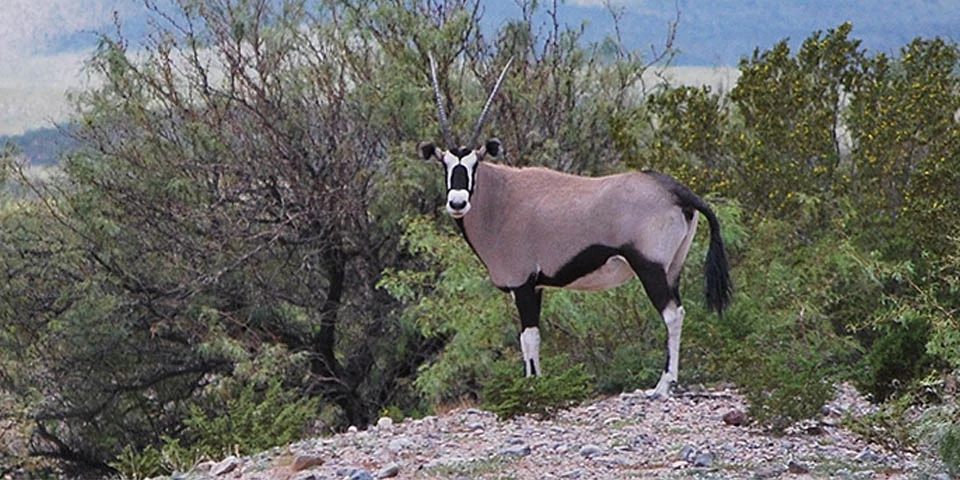
NPS Photo
Oryx (Gemsbok) Oryx gazella Exotic species, or non-native plants or animals that have been introduced into an area, are often very detrimental to native plants, animals, and ecosystems. At White Sands National Park, the oryx is one such species. To reduce the impact this animal has on the White Sands National Park ecosystem, certain measures have been implemented to keep oryx out the park. Native to the Kalahari Desert, the African oryx, or gemsbok (Oryx gazella), is a large antelope that now lives in southern New Mexico. It weighs on average up to 450 pounds (204 kg) and stands 47 inches (1.2 meters) tall at the shoulder, almost as tall as the roof of the average car. Both male and female oryx have horns that average 34 inches long (.86 meter). Their brown coloring with distinctive black-and-white markings enables them to hide among desert shrubs. To increase large game opportunities for hunters, the New Mexico Department of Game and Fish wanted to establish an exotic animal population in an area where there were few species of big game. Several species were considered, including the greater kudu, which turned out to be highly susceptible to cattle diseases and was never released into the wild. The ibex, a member of the goat family from Siberia and Iran, was introduced into the Florida Mountains near Deming, New Mexico. The ibex successfully colonized in that area and has begun to move out of the mountains and into the flats. The African Barbary sheep was introduced on land near Picacho, New Mexico. It too is now well established and has expanded its range. Between 1969 and 1977, 95 oryx were released on White Sands Missile Range and the surrounding areas. Wild oryx were brought from the Kalahari Desert in Africa to an experimental range at Red Rock, New Mexico. Federal law prohibits introducing wild animals from other countries into the wild, so offspring were obtained from these first oryx to introduce onto the missile range. There are thousands of oryx in residence on the missile range today. Annual hunts for the oryx began in 1974 and continue to this day to help control and stabilize the population. Because the oryx is not native to this country, the National Park Service (NPS) is concerned about how this animal affects the native plants and animals of White Sands National Park. In 1996, the NPS erected a 67-mile (108 km) boundary fence to prevent the oryx from entering the park. The success of the oryx in New Mexico is due in part to the abundance of food. In Africa, they eat grasses, forbs, and melons. Here, they feed on desert grasses, yucca, buffalo gourds, and mesquite bean pods. They are especially adapted to desert life and can go a long time without drinking water. This area also lacks a way to control the population. Lions and other natural predators cull the population in Africa, with only 10% of calves reaching one year of age. In New Mexico, predators like coyotes and mountain lions are not effective at controlling numbers, allowing the oryx to reproduce without restriction. |
Last updated: August 27, 2023
